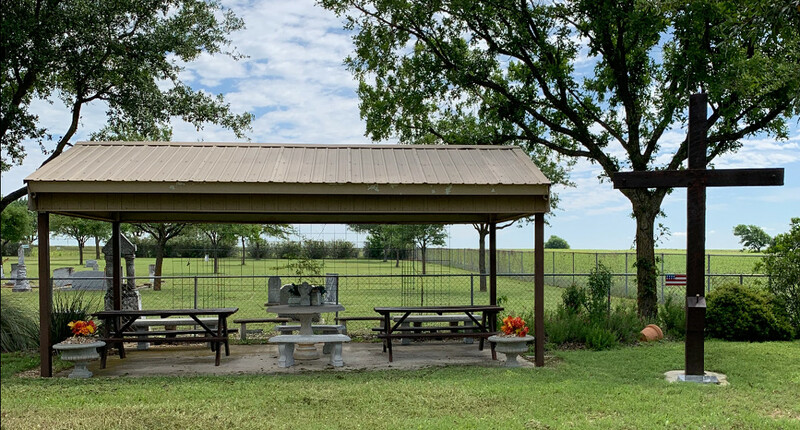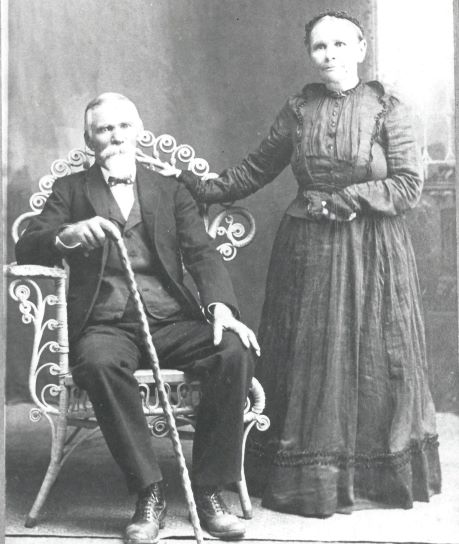
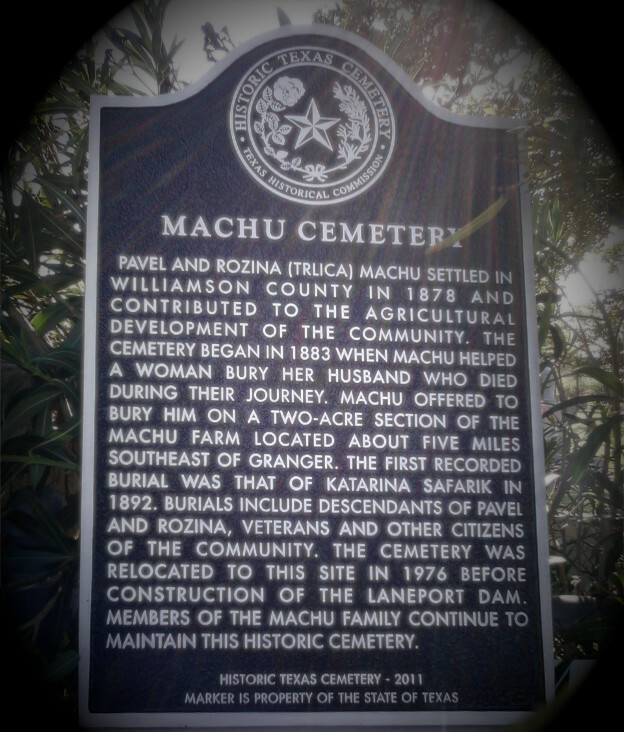
The Williamson County Historical Commission granted a historical marker to our 140 y.o. cemetery in 2013. The marker recognizes our Texas patriarch and matriarch, Pavel and Rozina (Trlica) Machu, their contributions to the development of the local community, and recounts the unique origin of the cemetery. A more detailed history is provided below.
The Machu Family originated in Seninka, Moravia, a short distance south of Vsetin. The oldest member whom the family has information on is Jan Machu, who was born in 1756 at house #32 and died there in 1816. Jan was a quarter farmer and he married Rozina Cedidlo in 1795. Eight children were born to this couple and one of them was Pavel's father, Josef Machu, born on 31 July 1798 at #23 Seninka. Josef’s first marriage to Tereza Reznicek produced a son, Pavel Martin, born 13 August 1817. Josef was married secondly to Anna Zrnik in February 1826. This marriage produced two sons: Joseph Machu, born 1829 and Pavel Machu, born 8 February, 1834, both born at house #23 in Seninka. Anna Zrnik Machu died on July 10, 1836, leaving Josef with seven year old Joseph and two year old son Pavel.
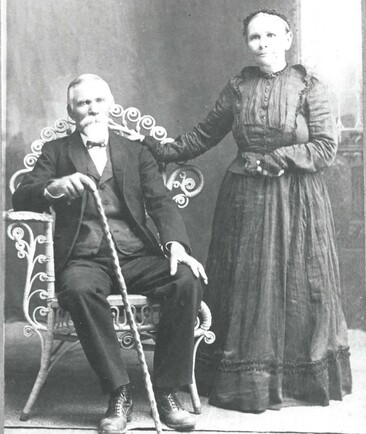
The Machu Family in Texas patriarch and matriarch: Pavel and Rozina (Trlica) Machu [Row 3, 3 columns left of the main drive.]
Imagine – at the age of 2, his mother dies. At 13, Pavel’s father dies. Such circumstances certainly contributed to his early maturity and self-reliant character and when the time arrived, Pavel dutifully served his mandatory service in the Austrian army. Afterward, he went to Usti where he met and married Rozina Trlica in 1864. The couple lived in house #62 – one that still stands and is occupied today. Pavel applied for permission to emigrate on March 1, 1870. The family set sail from the port of Bremen, Germany on April 7 and arrived in Galveston, Texas on June 2. The three children who came to the United States States of America with them – Anna who later married Joseph Friedrich Cervenka, Jan T. who married Veronika Pokorny, and Pavel H., who married Rozie Wentrcek. During the voyage, it is said that Pavel became so sick that Rozina was afraid that he was going to die. He survived, thankfully, and proceeded to accomplish many things during the years he lived in Texas. The family first settled in Austin County where they lived for eight years. Because of Pavel's health issues, they moved to Polanka, south of Taylor where they lived for a year, then to the community of Circleville on the banks of the San Gabriel River and finally to land Pavel purchased about five miles southeast of Granger. The “Machu” homestead was commonly recognized as its own community east of Granger and is reflected as such on early Williamson County maps.
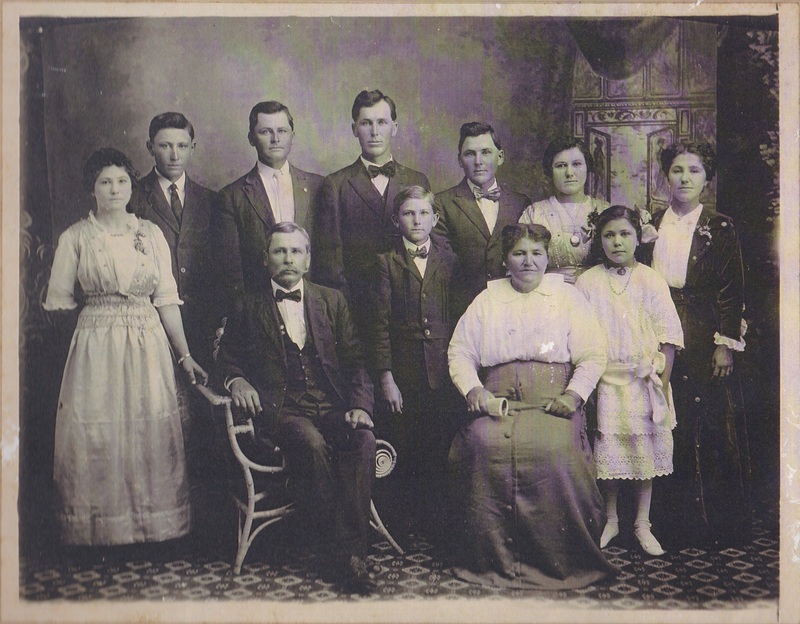
Pavel and Rozina had 9 children: Anna, Paul, Rosie, Joe R., Frances, Charles, Mary, Frank Louis, and John T. (he, his wife Veronika, and children are pictured here).
Pavel's brother, Josef, married Rozina Mazac. This couple and their daughter, Veronika arrived in Texas in May, 1871, settling in the Lavaca/Austin County area. Their daughter, Veronika Machu, married Paul Trlica. They were the parents of John P. Trlica, the well-known Granger photographer.
Imagine - an immigrant with no education and no English language skills managed to provide a school in central Texas for the children of his fellow countrymen from Moravia. Pavel committed himself to getting the Moravia School built, aided by the other farmers living nearby. Pavel donated a portion of his farm for the school, and he traveled to surrounding towns on horseback, soliciting funds for the construction costs. It was at this school that the newly organized SPJST Fraternal Lodge #20 held their first meetings. Pavel and Rozina were charter members of this benevolent organization’s local chapter.
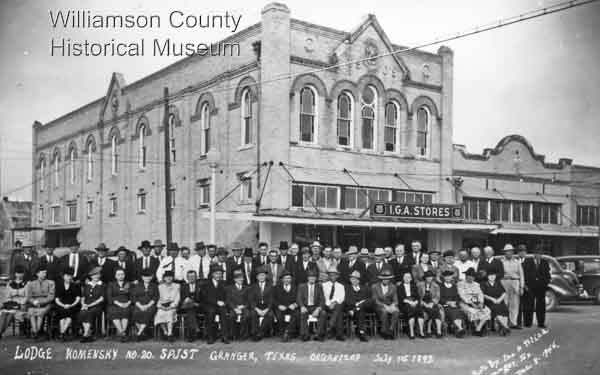
Pavel and Rozina were among the founding members of Granger's Lodge 20 of the Czech fraternal insurance group SPJST. Members posed here in front of the lodge hall, a city property the lodge purchased from Rozina in 1907. Photo taken by Pavel and Rozina's nephew John P. Trlica, the well-known Granger photographer.
After Pavel died in 1907, the SPJST purchased from Rozina the property on West Davilla Street in Granger where the new lodge found its permanent second-story home. The Machu name can still be found on one of the front door thresholds of this city block.
Pavel and others was instrumental in establishing the first Czech Protestant church in this area of central Texas, the Czech Moravian Brethren Church, a denomination whose origins date back to the 15th century Hussites of Bohemia. The first church services for the Czech Protestants in the area were held at the Moravia School.
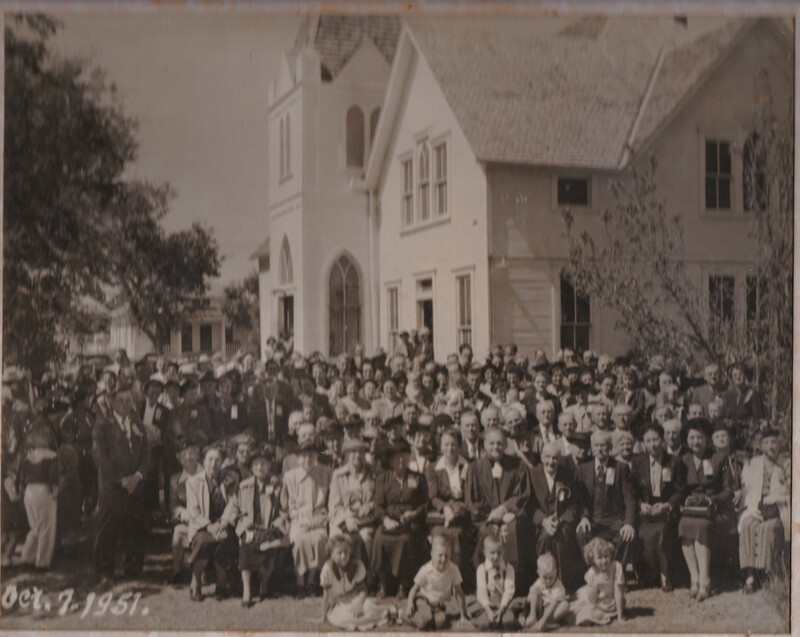
The Machu family served in their community to establish many institutions - the Moravia School, a Czech fraternal insurance organization SPJST, and Czech Protestant faith community known as the Unity of the Brethren Church. Over 20 family members are shown in this pic of that denomination's state convention held at the Granger Brethren church in the 1950s.
Pavel and others were instrumental in establishing the CMB Church in Granger, under the guidance of Rev. Adolph Chlumsky. He also provided assistance to those of the Catholic faith in building their new church in Granger – the church dedicated to the 9th century Christian missionaries to the Slavic peoples of Europe, Sts. Cyril & Methodius. His Catholic neighbors, in turn, offered assistance to build the Czech Brethren Church. This was a noteworthy accomplishment in those days for first and second generation eastern European immigrants of Catholic and Protestant Christian faiths since the historic tension between the two groups following centuries of religious wars back in Europe was often transported here. Such tensions were not to be found in Granger. The two churches today continue to stand side-by-side on the west side of town.
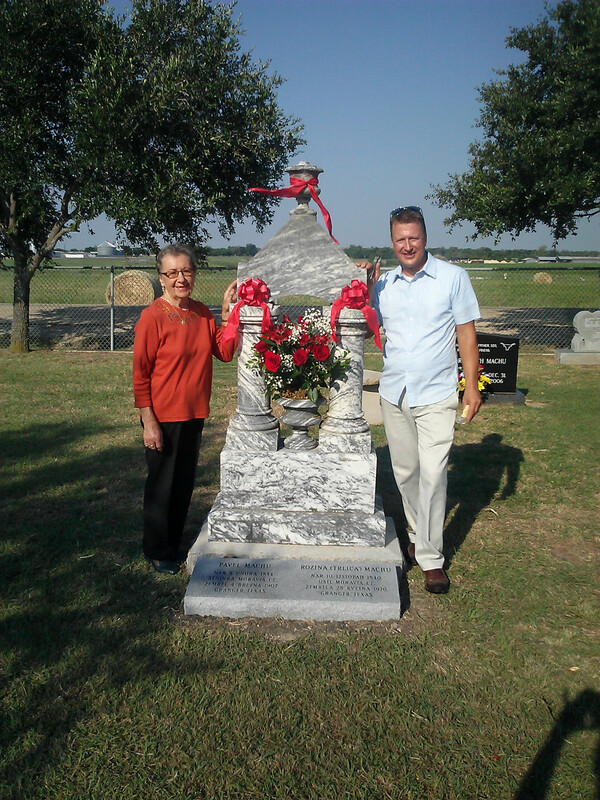
Rubie Loessin (eldest daughter of Albin E. Machu) and her son Terry Loessin (eldest grandchild of Albin E. Machu) stand beside Pavel and Rozina's monument stone at the family cemetery.
When Pavel was approached by a lady with her deceased husband in her wagon who needed a place to bury him, Pavel’s act of charity that day, providing a place on his farm for her need, launched what became the Machu Family Cemetery. This large cemetery was relocated to the eastern edge of the city of Granger in the early 1970’s by the U.S. Army Corps of Engineers as “Machu”-land would soon be under the waters of new Lake Granger.
Pavel was a well-respected member of his community. You can document this by reading his obituary - it reports the church could not hold all the people who came to the service in 1907. Rozina died on May 28, 1920 with her children and 38 grandchildren present. Her son, Frank, had lived with her since Pavel’s death. Pavel and Rozina are buried today in the Machu Cemetery.
The construction of the Laneport Dam on the north end of the San Gabriel River in Williamson County that would, de facto, create the new Lake Granger meant a host of small farms that had been handed down in local Czech families for years soon be underwater as well as the site of the old Moravia School. Also, several old cemeteries -- the Machu and Beard family cemeteries and that of the old Friendship community -- would have to be relocated. It is believed that Pavel Machu purchased his original 60 acres in rural Williamson County for 50 cents an acre. All but five acres of that original farm would be underwater by 1978 when the Dam was completed.
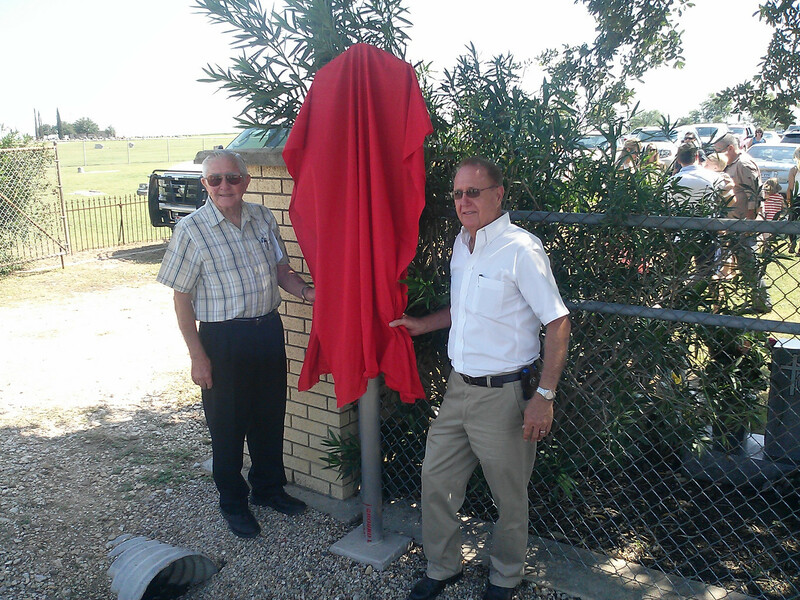
Darwin Machu (left) [son of Anton & Millie Machu] and Albin F. Machu (right) [son of Albin E. & Vlasta Machu] would certainly have made their parents proud. Both have labored tirelessly over the years toward improvements and maintenance at the family cemetery. Here they prepare to unveil the Williamson County Historical Marker at its dedication ceremony held on August 17, 2013. Over 200 guests attended, including family, city and county officials, community friends and neighbors. A special thank you to Darwin for his work on the research and acquisition of our historical marker.
The United States Corps of Engineers gave the cemetery association a 3-acre tract east of Granger and paid for the removal and reburial of the inhabitants and the difficult task of carefully transferring the monument stones. G. Truett Beard and Albin E. Machu were instrumental in assisting with the work of relocating this group of cemeteries - including their own two families - to the new location and would be honored in 1981 with Take Pride in America plaques presented to them by the U.S. Corps of Engineers. And not just for their work with the cemetery, the two men were also recognized for their work in "providing sight reports of protected wildlife species, the protection and supplemental feeding of pheasant and wild turkey populations during stocking efforts, and the surveillance for illegal hunting -- volunteer efforts on their part that would help to establish the multiple game preserves enjoyed around the lake area today."
Albin E. Machu recalled in a news article at the time his days working alongside Corps laborers during this process and the reverence that was observed by all involved. "It didn't offend me a bit, I'd been around this cemetery all my life and now it was getting a new home. We're going to work to make it beautiful and a real peaceful place for generations to come. One the whole family can take pride in." He would bring his grandson, Terry Loessin (at the time a 7th grader) to the site to observe the activity. Loessin, who would later spend almost 15 years as a high school history instructor, would later credit the experience for stirring his initial interest in the past. "Watching the workers in their archaeological work - bagging the remains that included small Czech bibles, silver infant rattles with Czech inscriptions on them, and the unusually high number of infant graves and the questions that stirred in me about infant mortality rates at that time - the whole experience had quite an effect on me."
A "beautiful and real peaceful place for generations to come" -- indeed. Today any can come to visit this site with a remarkable history. A gazebo is provided for a day picnic, a cross to stir and inspire one's contemplations while there, and host of residents to remind us of the faith and courage of our ancestors. We encourage you to visit and support our efforts in maintaining the site - visit our Donations page!
Sources include: Bratrske Listy, Pavel Machu Obituary authored by Rev. Adolf Chlumsky, April 1907; Looking Back at the Cervenka and Machu Family 1773-1988, by Joan Cervenka Cobb, 1988
